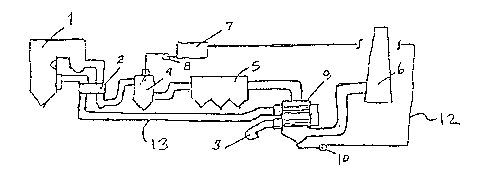Some of the information on this Web page has been provided by external sources. The Government of Canada is not responsible for the accuracy, reliability or currency of the information supplied by external sources. Users wishing to rely upon this information should consult directly with the source of the information. Content provided by external sources is not subject to official languages, privacy and accessibility requirements.
Any discrepancies in the text and image of the Claims and Abstract are due to differing posting times. Text of the Claims and Abstract are posted:
| (12) Patent: | (11) CA 2130204 |
|---|---|
| (54) English Title: | DRY SCRUBBER WITH CONDENSING HEAT EXCHANGER FOR CYCLE EFFICIENCY IMPROVEMENT |
| (54) French Title: | EPURATEUR A SEC AVEC ECHANGEUR DE CHALEUR A CONDENSATION POUR RENDEMENT AMELIORE DU CYCLE |
| Status: | Expired and beyond the Period of Reversal |
| (51) International Patent Classification (IPC): |
|
|---|---|
| (72) Inventors : |
|
| (73) Owners : |
|
| (71) Applicants : | |
| (74) Agent: | SMART & BIGGAR LP |
| (74) Associate agent: | |
| (45) Issued: | 1997-10-14 |
| (22) Filed Date: | 1994-08-08 |
| (41) Open to Public Inspection: | 1995-02-11 |
| Examination requested: | 1994-08-08 |
| Availability of licence: | N/A |
| Dedicated to the Public: | N/A |
| (25) Language of filing: | English |
| Patent Cooperation Treaty (PCT): | No |
|---|
| (30) Application Priority Data: | ||||||
|---|---|---|---|---|---|---|
|
A system for controlling sulfur dioxide (SO2) in a flue
gas produced by a boiler comprises an air heater connected to
the boiler for cooling the flue gas produced by the boiler.
A dry scrubber is connected to the air heater and a slurry
source for receiving the heated flue gas and a slurry in order
to remove SO2 from the flue gas. A particulate collector is
connected to the dry scrubber in order to collect particles
from the flue gas. Heat is recovered from the flue gas by
connecting a condensing heat exchanger to the particulate
collector; and a condensate recycler is connected to the
condensing heat exchanger and the slurry source for reducing
the water requirements for the system.
Système pour contrôler le dioxyde de soufre (SO2) dans un gaz de combustion produit par une chaudière comprenant un réchauffeur d'air raccordé à la chaudière pour refroidir le gaz de combustion produit par la chaudière. Un épurateur à sec est raccordé au réchauffeur d'air et à une source de boue pour recevoir le gaz de combustion chauffé et la boue pour extraire le SO2 du gaz de combustion. Un collecteur de particules est raccordé à l'épurateur à sec pour recueillir les particules du gaz de combustion. La chaleur est récupérée du gaz de combustion en raccordant un échangeur-condenseur au collecteur de particules; et une unité de recyclage de condensats est raccordée à l'échangeur-condenseur et à la source de boue pour diminuer les besoins en eau du système.
Note: Claims are shown in the official language in which they were submitted.
Note: Descriptions are shown in the official language in which they were submitted.

2024-08-01:As part of the Next Generation Patents (NGP) transition, the Canadian Patents Database (CPD) now contains a more detailed Event History, which replicates the Event Log of our new back-office solution.
Please note that "Inactive:" events refers to events no longer in use in our new back-office solution.
For a clearer understanding of the status of the application/patent presented on this page, the site Disclaimer , as well as the definitions for Patent , Event History , Maintenance Fee and Payment History should be consulted.
| Description | Date |
|---|---|
| Inactive: IPC from MCD | 2006-03-11 |
| Inactive: IPC from MCD | 2006-03-11 |
| Inactive: IPC from MCD | 2006-03-11 |
| Inactive: IPC from MCD | 2006-03-11 |
| Inactive: IPC from MCD | 2006-03-11 |
| Time Limit for Reversal Expired | 2003-08-08 |
| Letter Sent | 2002-08-08 |
| Grant by Issuance | 1997-10-14 |
| Inactive: Application prosecuted on TS as of Log entry date | 1997-08-07 |
| Inactive: Status info is complete as of Log entry date | 1997-08-07 |
| Pre-grant | 1997-04-30 |
| Notice of Allowance is Issued | 1997-03-04 |
| Application Published (Open to Public Inspection) | 1995-02-11 |
| All Requirements for Examination Determined Compliant | 1994-08-08 |
| Request for Examination Requirements Determined Compliant | 1994-08-08 |
There is no abandonment history.
The last payment was received on
Note : If the full payment has not been received on or before the date indicated, a further fee may be required which may be one of the following
Please refer to the CIPO Patent Fees web page to see all current fee amounts.
| Fee Type | Anniversary Year | Due Date | Paid Date |
|---|---|---|---|
| Final fee - standard | 1997-04-30 | ||
| MF (application, 3rd anniv.) - standard | 03 | 1997-08-08 | 1997-08-01 |
| MF (patent, 4th anniv.) - standard | 1998-08-10 | 1998-07-22 | |
| MF (patent, 5th anniv.) - standard | 1999-08-09 | 1999-07-20 | |
| MF (patent, 6th anniv.) - standard | 2000-08-08 | 2000-07-20 | |
| MF (patent, 7th anniv.) - standard | 2001-08-08 | 2001-07-19 | |
| MF (application, 2nd anniv.) - standard | 02 | 1996-08-08 |
Note: Records showing the ownership history in alphabetical order.
| Current Owners on Record |
|---|
| THE BABCOCK & WILCOX COMPANY |
| Past Owners on Record |
|---|
| J. WILLIAM SMITH |